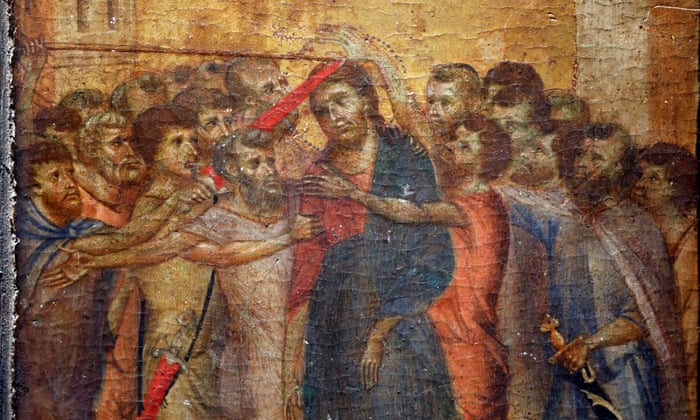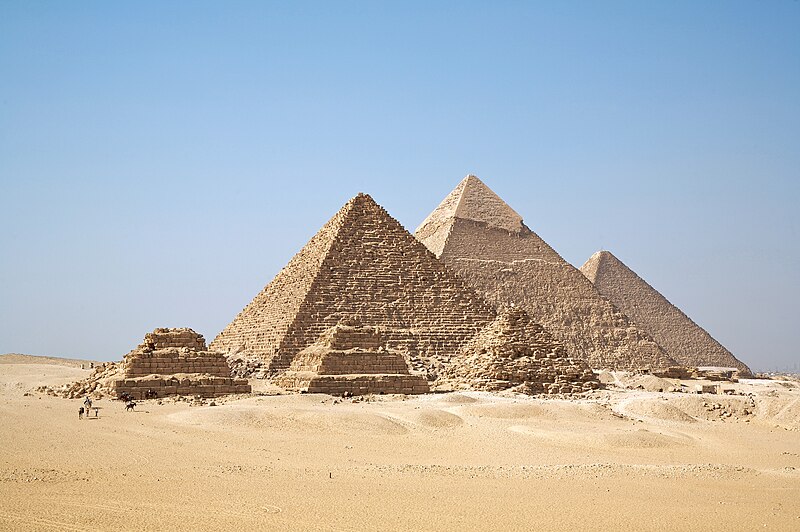This class begins in the mists of ancient prehistory, and traces the evolution of human visual culture through the development of civilizations like Sumeria and Ancient Egypt, the classical Greeks and Romans, up to the very beginnings of the European Renaissance, and covers some of the most surprising, exciting, and beautiful artworks created by humans.
Art 101
Friday, November 20, 2020
Welcome to Art 101
This class begins in the mists of ancient prehistory, and traces the evolution of human visual culture through the development of civilizations like Sumeria and Ancient Egypt, the classical Greeks and Romans, up to the very beginnings of the European Renaissance, and covers some of the most surprising, exciting, and beautiful artworks created by humans.
Sunday, December 8, 2019
Tuesday, November 26, 2019
Thursday, November 21, 2019
Tuesday, October 29, 2019
Renaissance painting found in kitchen in France sells for €24m

An tiny early Renaissance masterpiece found in a French woman’s kitchen during a house clearance has fetched more than €24m at auction, making it the most expensive medieval painting ever sold.
Christ Mocked, by the 13th-century Florentine painter Cimabue, had hung for decades above a cooking hotplate in the open-plan kitchen of a 1960s house near Compiègne, north of Paris. It had never attracted much attention from the woman, in her 90s, or her family, who thought it was simply an old icon from Russia. It might have ended up in a bin during the house move this summer had it not been spotted by an auctioneer who had come to value furniture....
Continue reading at The Guardian:https://www.theguardian.com/world/2019/oct/27/renaissance-painting-cimabue-found-kitchen-france-sells-24m-euros-auction
Saturday, October 26, 2019
Quiz 2 Study Guide Captions
Statues from the Abu Temple at Tell Asmar, c. 2700–2500 B.C. Limestone, alabaster, and gypsum, tallest figure approx. 30 in. high.
Victory stele of Naram-Sin Akkadian Empire, Mesopotamia, ca. 2,254 - 2,218 B.C.E. Pink sandstone 6 ft 6 in. high
The Warka Vase, from Uruk, c. 3500–3000 B.C. Alabaster, 3 ft.
Standard of Ur from Tomb 779, Royal Cemetery Ur (modern Tell Muqayyar) Iraq ca. 2,600 B.C.E. wood, shell, lapis lazuli, red limestone approximately 8 x 19 in.
Stele with Code of Hammurabi, Babylon, Mesopotamia, ca. 1,792 - 1,750 B.C.E., basalt, Approx 7 ft high
Dying Lioness (detail of The Great Lion Hunt), palace of King Assurnasirpal II, Nimrud, Iraq, ca. 668 - 627 B.C.E. alabaster relief panel, 13.75" h
Rosetta Stone, 196 BC, black basalt, 3'9" high *written in 3 scripts: hieroglyphics, demotic, and Greek. (the key to decoding hieroglyphics).
Palette of Narmer, from Hierakonpolis, c. 3100 B.C. Slate, 25 in. high
Pyramids at Giza, Egypt, 2551-2472 BC, Old Kingdom limestone - built for Khufu. Khafre, & Menkaure (3 old kingdom pharaohs of the 4th dynasty) - Khufu's is the largest at 480' high, each side of base 755' long
Toreador Fresco (also called The Leaping Bull Fresco), from Knossos, Crete, c. 1500 B.C. Reconstructed fresco, 32 in. (81.3 cm) high (including border).
Snake Goddess, from Knossos, Crete, c. 1600 B.C. Faïence, 131⁄2 in. (34.3 cm) high
Octopus Vase, from Palaikastro, Crete, c. 1500 B.C. 11 in. (27.9 cm) high.
"Treasury" of Atreus, Mycenae, 13th century B.C. Diameter of interior 43 ft. , height 40 ft.; doorway 17 ft. 8 in. × 8 ft. 10 in.
Metropolitan Kouros, from Attica, c. 590–580 B.C. (Archaic Period). Naxian marble, H. without plinth: 76 in
Poseidon or Zeus (AKA The Artemision Bronze), found in the sea off Cape Artemision, c. 450 B.C. Bronze, made using "lost wax casting" method, 6 ft. 101⁄4 in. (2.09 m) high
Myron, Discobolus (Discus Thrower), Roman copy of an ancient Greek bronze from c. 450 B.C.E., Classical Period, height 61 ins
Parthenon, Athens, 447–438 B.C. (Classical Period) Pentelic marble, 111 × 237 ft.
Winged Nike (Winged Victory), from Samothrace, c. 190 B.C. (Hellenistic period), Marble, approx. 8 ft. (2.44 m) high.
Boxer (AKA Seated Boxer), 2nd or early 1st century B.C. (Hellenistic period) Bronze, 4 ft. 21⁄2 in. (1.28 m) high.
Capitoline Wolf, previously believed c. 500B.C., now thought to be a Medieval copy, Bronze, 2 ft. 91⁄2 in. (85.1 cm) high.
Sarcophagus from Cerveteri, c. 520 B.C., Etruscan,Painted terra-cotta, 6 ft. 7 in. (2 m) long.
Scene from the back of a mirror from Volterra, showing Uni (equivalent to the Greek Hera and the Roman Juno) nursing Herakles in the presence of other gods, Etruscan, c. 350 –300 B.C. Bronze, engraved.
Liver of Piacenza, lifesize divination chart of a sheep liver, Etruscan, engraved bronze, ca 5 X 4 X 3 ins.
Victory stele of Naram-Sin Akkadian Empire, Mesopotamia, ca. 2,254 - 2,218 B.C.E. Pink sandstone 6 ft 6 in. high
The Warka Vase, from Uruk, c. 3500–3000 B.C. Alabaster, 3 ft.
Standard of Ur from Tomb 779, Royal Cemetery Ur (modern Tell Muqayyar) Iraq ca. 2,600 B.C.E. wood, shell, lapis lazuli, red limestone approximately 8 x 19 in.
Stele with Code of Hammurabi, Babylon, Mesopotamia, ca. 1,792 - 1,750 B.C.E., basalt, Approx 7 ft high
Dying Lioness (detail of The Great Lion Hunt), palace of King Assurnasirpal II, Nimrud, Iraq, ca. 668 - 627 B.C.E. alabaster relief panel, 13.75" h
Rosetta Stone, 196 BC, black basalt, 3'9" high *written in 3 scripts: hieroglyphics, demotic, and Greek. (the key to decoding hieroglyphics).
Palette of Narmer, from Hierakonpolis, c. 3100 B.C. Slate, 25 in. high
Pyramids at Giza, Egypt, 2551-2472 BC, Old Kingdom limestone - built for Khufu. Khafre, & Menkaure (3 old kingdom pharaohs of the 4th dynasty) - Khufu's is the largest at 480' high, each side of base 755' long
The Great Sphinx, Colossal statue of Khafre, Giza, c. 2520–2494 B.C. Limestone, 66 ft. high, 240 ft. long.
Canopic jars of Neskhons, From Deir el-Bahari, Upper Egypt 21st Dynasty, 1069-945 BC containing organs removed during mummification
Statue of Hatshepsut as Pharaoh, 18th Dynasty, c. 1495 B.C.E. Granite, 7' 11" high.
Bust of Nefertiti 1349-1336 BCE painted limestone 19" high, Amarna period
Akhenaten and Nefertiti and their children, Amarna period, c. 1349 - 1336 BCE Painted limestone relief, 13 x 15"
Mask of Tutankhamun, c. 1327 B.C.E. Gold inlaid with enamel and semiprecious stones, 21 1/4" high.
Female Cycladic idol, from Amorgos, 2700–2300 B.C. Marble, 4 ft. 101⁄2 in. (1.49 m) high
Canopic jars of Neskhons, From Deir el-Bahari, Upper Egypt 21st Dynasty, 1069-945 BC containing organs removed during mummification
Statue of Hatshepsut as Pharaoh, 18th Dynasty, c. 1495 B.C.E. Granite, 7' 11" high.
Bust of Nefertiti 1349-1336 BCE painted limestone 19" high, Amarna period
Akhenaten and Nefertiti and their children, Amarna period, c. 1349 - 1336 BCE Painted limestone relief, 13 x 15"
Mask of Tutankhamun, c. 1327 B.C.E. Gold inlaid with enamel and semiprecious stones, 21 1/4" high.
Female Cycladic idol, from Amorgos, 2700–2300 B.C. Marble, 4 ft. 101⁄2 in. (1.49 m) high
Sarcophagus from Cerveteri, c. 520 B.C., Etruscan,Painted terra-cotta, 6 ft. 7 in. (2 m) long.
Scene from the back of a mirror from Volterra, showing Uni (equivalent to the Greek Hera and the Roman Juno) nursing Herakles in the presence of other gods, Etruscan, c. 350 –300 B.C. Bronze, engraved.
Liver of Piacenza, lifesize divination chart of a sheep liver, Etruscan, engraved bronze, ca 5 X 4 X 3 ins.
Friday, October 25, 2019
Subscribe to:
Posts (Atom)


























,+completed+537+.jpg)




































